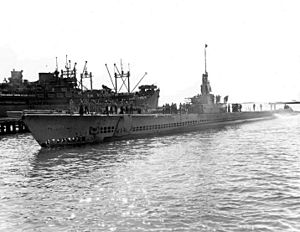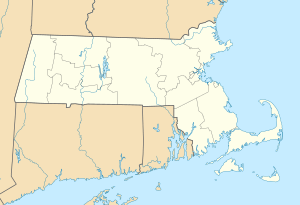USS Lionfish facts for kids

USS Lionfish
|
|
| History | |
|---|---|
| Name | Lionfish |
| Namesake | Lionfish |
| Builder |
|
| Yard number | 553 |
| Laid down | 15 December 1942 |
| Launched | 7 November 1943 |
| Sponsored by | Mrs. Harold C. Train |
| Commissioned | 1 November 1944 |
| Decommissioned | 16 January 1946 |
| Recommissioned | 31 January 1951 |
| Decommissioned | 15 December 1953 |
| Stricken | 20 December 1971 |
| Status | Museum ship at Battleship Cove, Fall River, Massachusetts since 30 August 1972 |
| General characteristics | |
| Class and type | Balao-class submarine |
| Displacement |
|
| Length | 311 ft 6 in (94.95 m) |
| Beam | 27 ft 3 in (8.31 m) |
| Draft | 16 ft 10 in (5.13 m) maximum |
| Propulsion |
|
| Speed |
|
| Range | 11,000 nmi (20,000 km; 13,000 mi) surfaced at 10 knots (19 km/h; 12 mph) |
| Endurance |
|
| Test depth | 400 ft (120 m) |
| Complement | 10 officers, 70–71 enlisted |
| Armament |
|
|
USS Lionfish (SS-298)
|
|
| Location | Fall River, Massachusetts |
| Built | 1943 |
| NRHP reference No. | 76002270 |
| Significant dates | |
| Added to NRHP | 30 September 1976 |
| Designated NHL | 14 January 1986 |
The USS Lionfish (SS-298) was a special type of submarine called a Balao-class submarine. It was the only ship in the United States Navy named after the lionfish, a colorful fish from the Pacific Ocean. Today, the Lionfish is a National Historic Landmark and you can visit it at Battleship Cove in Fall River, Massachusetts.
Contents
Meet the USS Lionfish
The USS Lionfish is a famous submarine with a long history. It played a part in World War II and later became a museum. This article will tell you all about its journey from a warship to a historical treasure.
Building a Submarine
Work on the Lionfish started on December 15, 1942. This is called being "laid down." The submarine was then "launched" into the water on November 7, 1943. Mrs. May Philipps Train, whose husband was a Rear Admiral, was the sponsor for the ship.
The Lionfish officially joined the Navy on November 1, 1944. This is known as its "commissioning." Its first captain was Lieutenant Commander Edward D. Spruance. He was the son of a famous World War II admiral, Raymond Spruance.
World War II Adventures
After some test trips, called a "shakedown cruise," the Lionfish began its first war patrol. This was a mission to search for enemy ships in Japanese waters. This first patrol started on April 1, 1945.
First Patrol Missions
Just ten days into its first patrol, the Lionfish had a close call. It managed to avoid two torpedoes fired by a Japanese submarine. On May 1, the Lionfish used its deck guns to sink a Japanese schooner (a type of sailing ship).
Later, the submarine met up with another submarine, the USS Ray. The Lionfish then helped transport United States Army Air Forces pilots who had survived crashes. These pilots were from B-29 Superfortress planes. The submarine took them to Saipan in the Mariana Islands. After that, it went to Midway Atoll to get more supplies.
Second Patrol and End of War
The Lionfish started its second war patrol on June 2, 1945. On July 10, 1945, it fired torpedoes at a Japanese submarine. The crew heard explosions and saw smoke, but the Japanese submarine was not damaged. The Lionfish later fired at two more Japanese submarines.
Its second and final war patrol involved "lifeguard duty." This meant rescuing pilots who had crashed into the ocean off the coast of Japan. When World War II ended on August 15, 1945, the Lionfish sailed to San Francisco, California. It was taken out of service, or "decommissioned," on January 16, 1946.
After the War
The Lionfish was put back into service, or "recommissioned," on January 31, 1951. It then traveled to the United States East Coast for training trips. The submarine also took part in NATO exercises, which are training drills with other countries. It even went on a trip to the Mediterranean Sea.
On December 15, 1953, the Lionfish was decommissioned again at the Boston Navy Yard. In 1960, it was used as a training submarine for Navy reserves in Providence, Rhode Island. It was in service but not fully recommissioned.
A Museum Star
In 1971, the Lionfish was officially removed from the Navy's list of ships. However, its story didn't end there. In 1973, it found a new home as a memorial at Battleship Cove in Fall River, Massachusetts. Today, it is one of the most popular exhibits at the museum.
The Lionfish is special because it was never changed or modernized like many other submarines. It still looks much like it did during World War II. Because of its excellent condition and historical importance, it was named a National Historic Landmark in 1986. This means it's a very important historical site in the United States.
Special Awards
The USS Lionfish received several awards for its service:
- Asiatic-Pacific Campaign Medal with one battle star (for its service in the Pacific during the war)
- World War II Victory Medal (for serving during World War II)
- Navy Occupation Medal with "EUROPE" clasp (for its time in Europe after the war)
- National Defense Service Medal (for serving during times of national emergency)
More to Explore



